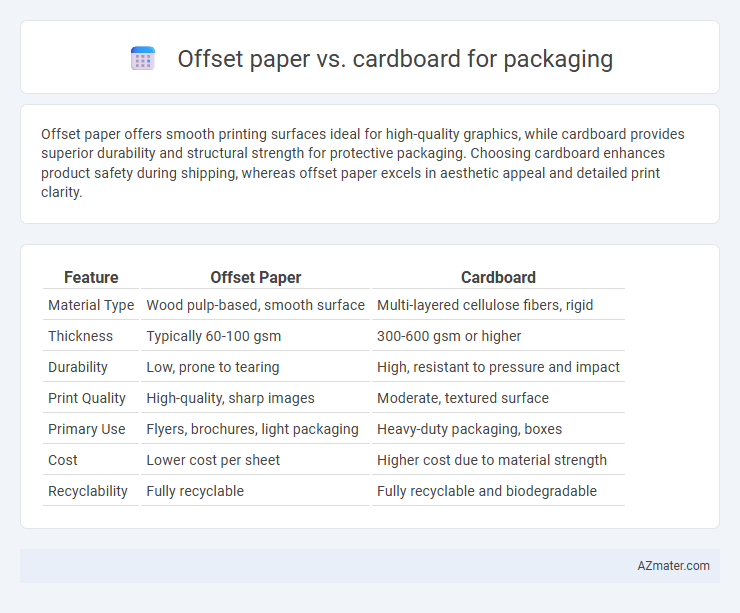Offset paper offers smooth printing surfaces ideal for high-quality graphics, while cardboard provides superior durability and structural strength for protective packaging. Choosing cardboard enhances product safety during shipping, whereas offset paper excels in aesthetic appeal and detailed print clarity.
Table of Comparison
| Feature | Offset Paper | Cardboard |
|---|---|---|
| Material Type | Wood pulp-based, smooth surface | Multi-layered cellulose fibers, rigid |
| Thickness | Typically 60-100 gsm | 300-600 gsm or higher |
| Durability | Low, prone to tearing | High, resistant to pressure and impact |
| Print Quality | High-quality, sharp images | Moderate, textured surface |
| Primary Use | Flyers, brochures, light packaging | Heavy-duty packaging, boxes |
| Cost | Lower cost per sheet | Higher cost due to material strength |
| Recyclability | Fully recyclable | Fully recyclable and biodegradable |
Introduction to Offset Paper and Cardboard
Offset paper, designed for high-quality printing, offers smooth surface properties that enhance ink absorption and image clarity, making it ideal for detailed packaging designs. Cardboard, composed of layered paper pulp, provides sturdy, durable structure essential for protective packaging and shipping purposes. Both materials serve distinct roles in packaging, with offset paper prioritizing visual appeal and cardboard emphasizing strength and protection.
Material Composition and Characteristics
Offset paper is primarily made from high-quality wood pulp, offering a smooth surface ideal for detailed printing and vibrant color reproduction, making it suitable for lightweight packaging requiring fine graphic presentation. Cardboard consists of multiple layers of paper pulp, often recycled, providing greater thickness, durability, and rigidity ideal for protective packaging and structural support. The composition differences result in offset paper being thin and flexible, while cardboard offers enhanced strength and cushioning, making each appropriate for distinct packaging needs based on material properties.
Printing Quality and Visual Appeal
Offset paper offers superior printing quality with sharp, vibrant colors and fine detail, making it ideal for high-end packaging that demands precision and clarity. Cardboard, while more durable and sturdy for protective packaging, tends to absorb ink differently, resulting in a less crisp print and muted colors compared to offset paper. Visual appeal is typically enhanced on offset paper due to its smooth surface and consistent texture, whereas cardboard's rougher surface can affect the sharpness and brightness of printed designs.
Durability and Protection Capabilities
Offset paper provides moderate durability and is suitable for lightweight packaging, offering a smooth surface ideal for high-quality printing and branding. Cardboard exhibits superior durability and protection capabilities due to its thicker, multi-layered structure, making it ideal for heavy-duty packaging and safeguarding fragile items during transit. The choice between offset paper and cardboard hinges on required strength and the level of protection necessary for the packaged product.
Environmental Impact and Sustainability
Offset paper offers moderate environmental benefits due to its recyclability and lower energy consumption in production, but its thin structure limits durability for packaging. Cardboard, especially corrugated varieties, excels in sustainability by being highly recyclable, biodegradable, and often made from recycled materials, supporting circular economy principles. Choosing cardboard over offset paper reduces environmental footprint through enhanced durability, resource efficiency, and minimal waste generation in packaging applications.
Cost Comparison and Budget Considerations
Offset paper offers a cost-effective solution for packaging due to its lower material and printing expenses, making it ideal for large-volume orders with detailed graphics. Cardboard, while generally more expensive, provides superior durability and protection, justifying higher upfront costs for heavy or fragile products. Budget considerations should balance the need for visual appeal and structural integrity against the per-unit cost differences to determine the most economical packaging choice.
Customization and Design Flexibility
Offset paper offers superior print clarity and precise color reproduction, making it ideal for intricate designs and high-quality branding in packaging. Cardboard provides greater structural customization with options for thickness, die-cut shapes, and eco-friendly coatings, suitable for durable and protective packaging solutions. Combining offset printing on cardboard allows brands to achieve both detailed visuals and robust packaging tailored to specific product needs.
Weight and Shipping Efficiency
Offset paper is lighter and thinner compared to cardboard, making it ideal for packaging that requires lower weight to reduce shipping costs. Cardboard offers greater strength and durability but adds significant weight, which can increase freight expenses and reduce shipping efficiency. Choosing offset paper enhances packaging efficiency for lightweight items, while cardboard is preferred for heavier products that need more protection during transit.
Common Uses in Packaging Industry
Offset paper is commonly used for high-quality printing on product labels, brochures, and lightweight packaging due to its smooth surface and excellent ink absorption. Cardboard, especially corrugated variants, is widely utilized for shipping boxes, protective packaging, and heavy-duty containers because of its durability and cushioning properties. The packaging industry favors offset paper for aesthetic appeal and branding, while cardboard is preferred for structural support and protection during transportation.
Choosing the Right Material for Your Packaging Needs
Offset paper offers excellent print quality and smooth surface ideal for detailed graphics and vibrant colors, making it suitable for lightweight packaging. Cardboard provides superior durability and structural strength, perfect for protecting heavier or fragile products during shipping and handling. Selecting the right material depends on balancing aesthetic appeal with functional requirements such as weight, protection level, and cost efficiency.

Infographic: Offset paper vs Cardboard for Packaging
 azmater.com
azmater.com